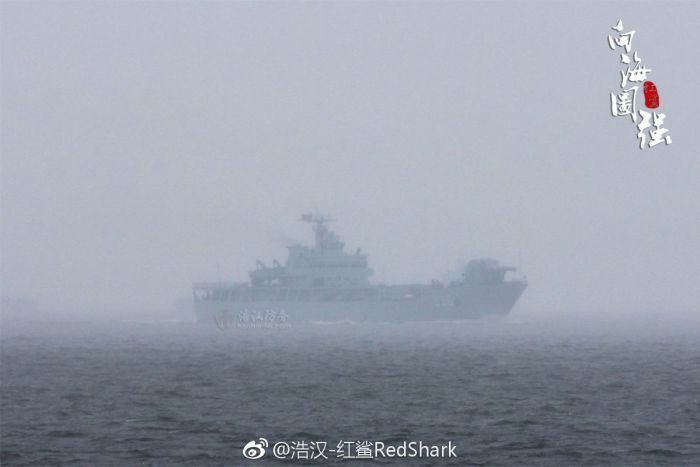A Chinese naval warship has been pictured out at sea carrying what appears to be an electromagnetic railgun.
A photo taken and posted by Weibo user (and prominent defence blogger) Haohan-Red Shark, purports to show the Type 072II Yuting-class tank landing ship Haiyangshan with a railgun mounted on its bow.
Compared to conventional artillery that uses gunpowder or cordite to fire projectiles — a practice that has been in wide use since the 1500s — a railgun uses a high-powered electric circuit to shoot a projectile along magnetic rails, firing at hypersonic speeds of Mach 5 or higher (five times the speed of sound).
While the US has been pursuing its railgun capability since 2005, China has seemingly taken the front foot, with anonymous sources confirming the existence of the weapon in 2011 to CNBC.
Since then, Chinese media has been incrementally filing news reports on the development on the technology, with the Global Times reporting in March that Zhang Xiao, an associate research fellow at the People’s Liberation Army’s (PLA) University of Engineering announced her research team was responsible for the “largest repeating power supply system in the world”.
The sighting, which comes as China marks the 70th anniversary of the Chinese Navy in 2019, appears to pre-date US intelligence estimates that Chinese railguns would arrive by 2025.
Dr Malcolm Davis, a senior analyst at the Australian Strategic Policy Institute, told the ABC the technology would usher in a “hemispheric battle space”.
“This would see belligerents able to strike at each other at distances ranging in the hundreds of kilometres”, Dr Davis said.
Compared to conventional naval artillery, the railgun does not fire explosives in the round, making warships a touch safer for those onboard, and naval artillery cheaper to acquire for militaries.
“If you think back to the World War II battle between the German battleship Bismarck and HMS Hood, the latter sunk within minutes because the Germans struck near ammunition magazines,” he said.
The development of the technology from various powers has been slow, given the incredibly large currents required to power railguns — about one million amps — and the practical implications this has on barrel design.
Previous US railgun tests saw barrels melt during firing, and current research has revolved around cooling the rails to maintain high energy per shot.
‘Americans aren’t going slow’
In the years since 2011, Chinese researchers have been testing the weapon at greater distances.
A US intelligence report found that China’s weapon would be able to strike 200 kilometres away with a projectile velocity of 2.5 kilometres per second (9,000kph — greater than Mach 7).
While US developments remain classified, the US Office of Naval Research (ONR) gave BAE systems $48.3 million to test phase 2 of their railgun program in 2013.
This phase will usher in the development of a multiple-shot railgun, alongside the development of a Hyper Velocity Projectile (HVP) that would see missiles fire at hypersonic speeds — technology that Russian President Vladimir Putin claimed Russia had successfully tested in December.
Speaking to website Task & Purpose, the US Strategic Capabilities Office’s (SCO) spokesperson Chris Sherwood said that the railgun was not high on the agenda.
“SCO shifted the project’s focus to conventional powder guns, facilitating a faster transition of HVP technology to the warfighter,” he said.
The US thus far has spent around $710.5 million on the railgun program, but experts fear it will languish as research weight pulls toward HVPs.
“The Americans certainly aren’t going slow. They’ve realised they’ve lagged behind Russia and China and are racing to catch up,” Dr Davis said.
“What’s happened in the past is that the US has years of research and development, but due to funding cuts, a decade of research goes dead in the water.”
Advanced technology part of Xi’s 2025 plan
China is no stranger to experiments in electromagnetic technology, having created one of the world’s first highways lined with solar-powered material to re-charge vehicles in transit.
This forms part of a broader Beijing strategy to move China away from being just a producer of everyday goods into one of advanced manufacturing, with about $US300 billion invested in the “Made in China 2025” plan.
The country already produces many of the world’s smartphones, and as its economic weight shifts toward domestic consumption, its push to spearheading technological advances follows in the footsteps of previous superpowers such as the US and Britain.
What also comes with being a superpower is the ability to project hard power across the globe, which China has not shied away from.
“So the 2020s presents a real risk of a US-China military clash, seeing as Xi Jinping has said he will not tolerate Taiwanese independence, and they’re not willing to let go of the South China Sea — which is fundamentally at odds with what the US wants.”
The Chinese foreign ministry and the Chinese Consulate have been contacted for comment.
Source – abcnews




